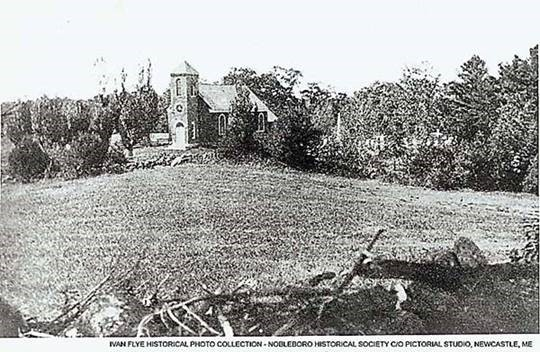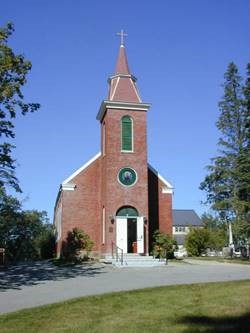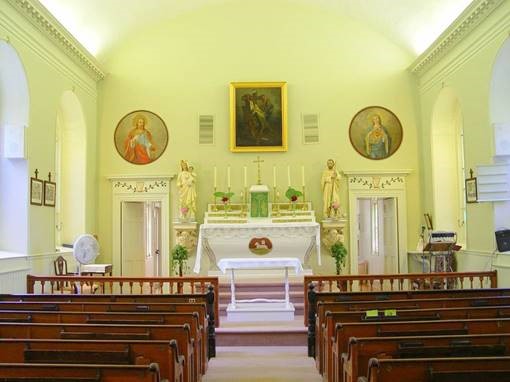Historic St. Patrick Church in Newcastle ready for St. Patrick’s Day
A St. Patrick’s Day Mass will be celebrated at St. Patrick Church, located on 380 Academy Hill Road in Newcastle, on Wednesday, March 17, at noon. St. Patrick Church was the first church in the country named for St. Patrick and has been in continual use longer than any other Catholic church in New England.
Over 200 years have passed since Bishop John Carroll, SJ, the first bishop of the Catholic Church in the U.S., requested a “good, brick church” to be built in Newcastle, Maine, to serve a growing number of Catholics in the area. Today, St. Patrick Church remains standing proudly as a symbol of faith and commitment to the Church.
St. Patrick houses countless historically significant artifacts, including the altar of Bishop Cheverus and a bell cast by Paul Revere & Sons. St. Patrick Church was designed by Irish architect Nicolas Codd and built on land donated by James Kavanagh and Matthew Cottrill, who had emigrated from County Wexford, Ireland, to Boston. The Kavanaghs, Cottrills, and others arrived in Newcastle in the 1790s.
“This church was the dream of two natives of Ireland who came to America to seek their fortune and find it they evidently did. But financial success was not enough for these men, James Kavanaugh and Matthew Cottrill,” said Bishop Robert Deeley. “They wanted their faith and the worship that was part of their faith to be a part of their community. The major part of the expense of building this church and maintaining this community in its early years relied on their financial and personal commitment. Their perseverance built this church. Their faith maintained a Catholic community.”
Fr. Jean-Louis Lefebvre de Cheverus, who had celebrated Masses in the area for many years, dedicated St. Patrick Church on July 17, 1808, having been appointed the first Bishop of Boston in April of that year.
“I performed the ceremony on the Sunday the 17th of this month,” Fr. Cheverus wrote to Bishop Carroll following the consecration. “The church is called St. Patrick’s...the name seemed to gratify our friends here. I like it myself because it proclaimed that our church here is the work of Irish piety.”
The altar used during the dedication Mass is still located in the church. A colonial era cemetery is located adjacent to the church, where the remains of early families like the Cottrills and Kavanaghs are interred. The style of St. Patrick Church is simple in its design with brick walls and mortar made from lime rock brought from Ireland. The church had five windows on each side and a semi-circular window gracing the balcony at the rear of the church. Parishioners worshipped on flat hand pegged benches with one such bench remaining today in the choir loft. The original color of the interior of the church was light grey-green, similar to the current color. A star, unique to buildings designed by Codd, decorated wood moldings on the outside of the church as well as on the doors of the sacristy. A large painting “Taking the Lord down from the Cross” was placed over the altar; the painting is said to have been given to the church by the mother of Bishop Cheverus.
In 1818, Cottrill donated a Paul Revere & Sons bell to the church, inscribed “The gift of Matthew Cottrill to St. Patrick’s Church, Newcastle, 1818.” From among the 400 bells cast by Paul Revere & Sons from 1792-1828, St. Patrick’s is one of 93 still in existence. A brick bell tower with a hip roof was added to the church in 1866. In the 1890s, the present spire topped with a wooden cross was added to the brick tower, the original clear windows were upgraded with stained glass windows, the benches were replaced with pews, and the ceiling and walls of the church were elaborately decorated. The first altar, built of wood pine logs, was later replaced with a granite altar.
In the early 1970s, the diocesan liturgical commission decided that St. Patrick Church should be restored, where possible, to its original simplicity. The frescoes, which had been added in the late 1800s, were eliminated and the walls repainted in the original pale tone. The sanctuary railing was restored and some of the statues removed. The 1896 stained glass windows donated by early parishioners and the pews were left in place. With the completion of the restoration, St. Patrick Church was accepted into the National Historic Registry as a building with historic significance. A historical museum on the church grounds features objects of interest including a cradle used by Newcastle native Edward Kavanagh, a U.S. Congressman (1831-1835) and the 17th Governor of Maine; items used in the early 19th century; and correspondence belonging to Bishop Cheverus.
The Feast Day of St. Patrick holds special significance as St. Patrick, along with Saint Jean Baptiste, is a secondary patron of the diocese. Bishop Deeley, whose parents came to the U.S. from County Galway, Ireland, will celebrate Mass on Saint Patrick’s Day at 12:15 p.m. at the Cathedral of the Immaculate Conception in Portland. The Mass will also be available via livestream at www.portlanddiocese.org/online-Mass. For more information about St. Patrick, the feast day, and St. Patrick’s Day events in Maine, visit www.portlanddiocese.org/content/feast-st-patrick-2021.
Event Date
Address
United States













































